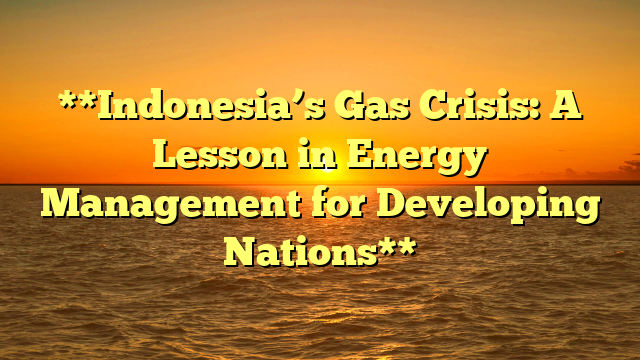
Indonesia, one of the world’s largest natural gas producers, is facing an unexpected crisis—gas shortages that have disrupted industries, increased energy costs, and strained public services. This paradox, where a resource-rich country struggles to meet its own energy demands, highlights critical issues in energy management. For developing nations, Indonesia’s gas crisis serves as a valuable lesson on the importance of long-term planning, infrastructure development, and a balanced energy policy.
At the heart of Indonesia’s gas crisis is the country’s declining production capacity. Many of its major gas fields, including those in East Kalimantan and Sumatra, are aging and producing less than before. Exploration for new reserves has been slow due to regulatory challenges, environmental concerns, and high operational costs. Developing nations that rely heavily on natural gas must recognize that resource depletion is inevitable and should invest in continuous exploration, improved extraction technologies, and alternative energy sources to avoid similar shortages.
Another major issue is the lack of adequate gas infrastructure. Indonesia’s vast archipelago makes energy distribution difficult, and the country’s pipeline network has not expanded at the same pace as its energy needs. Many industrial hubs and power plants rely on liquefied natural gas (LNG), which requires storage and regasification facilities that are not always available. This problem is not unique to Indonesia; developing nations must prioritize energy infrastructure investment to ensure a reliable supply chain. Governments should focus on expanding pipeline networks, improving storage facilities, and adopting smart grid technology to optimize distribution.
Indonesia’s gas export policy has also contributed to the domestic shortage. For decades, the country has prioritized long-term export contracts with countries like Japan, South Korea, and China, securing revenue but limiting domestic supply. While these agreements have boosted the economy, they have also left the country vulnerable to internal shortages when demand surges. Other resource-rich developing nations should learn from this by carefully balancing exports and domestic needs. Instead of relying solely on NS2121 – Situs Judi Online Terbaik , countries should implement flexible policies that allow for adjustments based on domestic consumption trends.
The gas crisis has also underscored the importance of energy diversification. Indonesia’s heavy dependence on fossil fuels, including natural gas, has left it exposed to supply disruptions. The transition to renewable energy sources such as solar, wind, and geothermal power can help developing nations reduce their reliance on finite resources. Investing in alternative energy technologies and improving grid integration can provide a more stable and sustainable energy supply, ensuring long-term energy security.
Lastly, government policies play a crucial role in preventing and managing energy crises. In Indonesia, slow policy responses and regulatory uncertainty have discouraged investment in the energy sector. To prevent similar issues, developing nations must establish clear, long-term energy policies that encourage private sector participation, streamline regulations, and offer incentives for sustainable energy investments. Proactive governance and strategic planning are essential for maintaining a stable energy supply.
In conclusion, Indonesia’s gas crisis serves as a powerful lesson in energy management for developing nations. From production challenges and infrastructure gaps to export policies and energy diversification, this crisis highlights key areas where strategic planning and investment are necessary. By learning from Indonesia’s experience, other countries can take proactive steps to avoid similar energy crises and build a more resilient and sustainable energy future.





